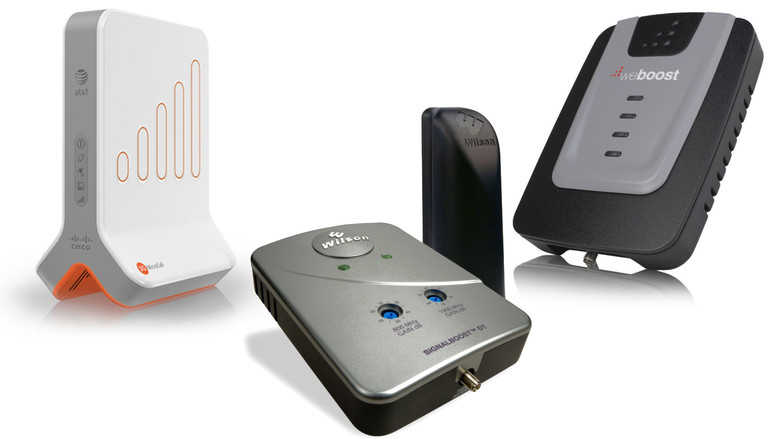
If you are tired of having to take your calls outside, then it is time for you to install a home cell signal booster. These handy repeater antennas can amplify your outdoor cellular signal to improve call quality and prevent drops. They are the cellular equivalent of a Wi-Fi amplifier for your home but a whole lot beefier. Without further ado, let’s dive in.
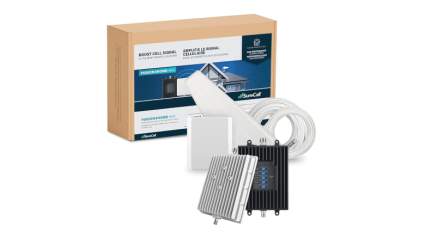
|
Amazon Customer Reviews
|
Price: $599.99 Shop at Amazon | Shop now Read our review |
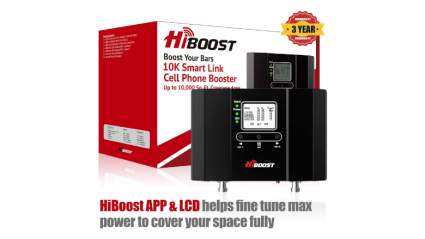
|
Amazon Customer Reviews
|
Price: $549.99 Shop at Amazon | Shop now Read our review |
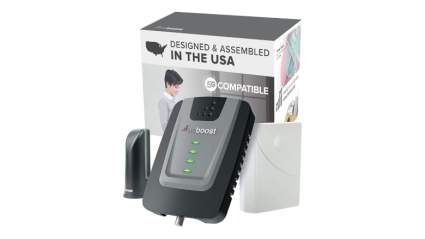
|
Amazon Customer Reviews
|
Price: $399.99 Shop at Amazon | Shop now Read our review |
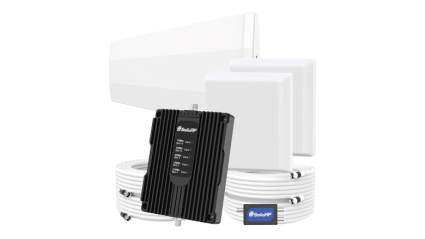
|
Amazon Customer Reviews
|
Price: $279.99 Shop at Amazon | Shop now Read our review |
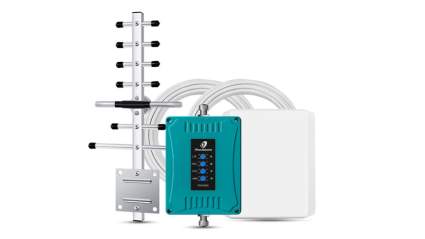
|
Amazon Customer Reviews
|
Price: $279.89 Shop at Amazon | Shop now Read our review |
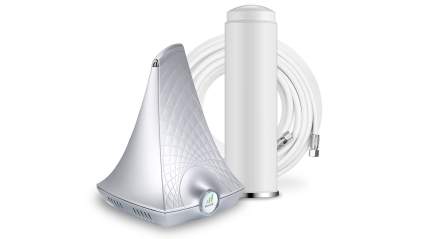
|
Amazon Customer Reviews
|
Price: $299.99 Shop at Amazon | Shop now Read our review |
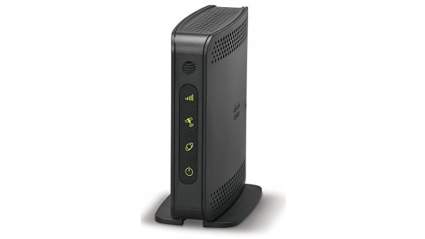
|
Amazon Customer Reviews
|
Price: $78.92 Shop at Amazon | Shop now Read our review |
-
1. SureCall Fusion4Home Max Signal Booster
Pros:- 72dB Max gain
- Boosts 4G/5G data and voice
- Covers up to 6,500 sq. ft.
Cons:- Tricky setup
- Power cord connects from the top of the unit
- No mounting pole included
The SureCall Fusion4Home Max is one of the most advanced pieces of consumer tech available when it comes to boosting the cellular signals from major North American cellphone carriers. It uses a combination of proprietary 2XP and ERT technology to deliver unmatched signal boosting for voice, text, and data on 5G/4G LTE.
Unlike other home boosting units, the Fusion4Home Max employs two amplifiers, one for the internal panel antenna and one for the external horn antenna. This does make the system slightly more involved to install (one more thing to mount) but the end result is a max 72 dB possible gain through the system. And that’s a lot of extra power for your incoming and outgoing signals.
Both antennas are quite powerful, as they can together take a minimum existing wireless signal (at least -100 dB) and amplify it to a usable level within a 6,500 sq. ft. area. It works with all major U.S. carriers including AT&T, Sprint, T-Mobile, U.S. Cellular, Verizon, and more, with receipts to prove it. It is also confirmed to work with all cellular standards including CDMA, WCDMA, GSM, EDGE, HSPA+, EVDO, and, of course, LTE.
All in all, this signal booster is a well-designed device that does exactly what it is supposed to. The only oversight in design is the fact that the power cord plugs into the top of the base unit rather than the bottom. That won’t stop me from recommending it, though, especially since other brands simply can’t match the raw power that the Fusion4Home Max offers.
Find more SureCall Fusion4Home Signal Booster information and reviews here.
-
2. HiBoost 10K Smart Link Cell Signal Booster
Pros:- LCD screen for easy tuning
- Compact and durable antennas
- Covers up to 10,000 sq. ft.
Cons:- Tricky setup
- Will drain battery on some phones
- Unit runs hot if poorly placed
The HiBoost 10K Smart Link Cell Signal Booster is a powerful signal booster that gets its name from its impressive 10,000 square foot coverage. This booster uses one low-profile outdoor antenna with one equally small indoor antenna to boost your incoming cellular signal by up to 65 dB.
The booster amplifies 4G, 3G, and 2G LTE bands, and is compatible with all major cell phone providers in the United States. It has a handy LCD screen that displays the uplink and downlink on each band. You can adjust their power here manually but most of the time you are better off repositioning the included wide-band directional antenna.
The HiBoost 10K comes with all the necessary equipment needed to mount its components. The process is pretty simple and is briefly detailed in the video below. The hardest part is getting the antenna to point towards an available signal, but a call to your cell service provider can help immensely.
The indoor flat panel antenna is smooth and fairly low profile, making it easy to blend in with surrounding decor. Though building materials make the effective coverage less than the advertised 10,000 square feet, it still offers indoor coverage on the higher end of the spectrum. The signal booster is designed to work with multiple users, and can theoretically support up to 100 simultaneous users.
The only shortcomings of this booster are minor. For example, the set includes only 30 feet of indoor coax and 50 feet of outdoor coax.
The included coaxial cables are only 30 ft., which helps maintain quality, but also limits where you can place both antennas. To add, the 10K’s metal case gets quite hot if you install it by a window or somewhere with poor ventilation.
Find more HiBoost 10K Smart Link Cell Signal Booster information and reviews here.
-
3. weBoost Home Room 4G LTE & 5G Signal Booster
Pros:- 60dB Max gain
- Boosts 4G/5G data and voice
- Covers up to 1,500 sq. ft.
Cons:- High price tag
- Directional outdoor antenna handles obstructions poorly
- Requires a minimum existing signal of -100dB
The weBoost Home Room 472120 is the latest and greatest consumer cell signal booster from these industry leaders. weBoost owns the company formally known as Wilson Electronics, which has been a major player in wireless signal boosting since the early ’90s.
This cell signal booster increases 4G LTE and 5G coverage for multiple phones, tablets, and computers. It is compatible with all US carriers, including Verizon, AT&T, Sprint, T-Mobile, Straight Talk, and U. S. Cellular. To set it up, you need to install an outdoor antenna using the included mount. Place it as high up as possible, preferably on a rooftop. You can call your service provider for help positioning it facing the nearest cell tower.
Next, you connect this antenna using a coaxial cable to the base unit indoors and plug it all in. This antenna is capable of boosting the gain of your signal by 60 dB. The internal antenna is only strong enough to carry the signal to a home office or small apartment. The max coverage is around 1,500 sq. ft. but results can vary based on the construction of your home.
Also, keep in mind that you need to get a minimum existing signal outside of your house for it to relay into your home. This is true for all signal repeaters. If your home has major obstructions around it like mountains or nearby radio equipment, your results can vary wildly.
All in all, the weBoost Home Room is a solid option, which is why you will also find this brand at the top of our list of the best mobile cell signal boosters.
Find more weBoost Home Room 4G LTE & 5G Signal Booster information and reviews here.
-
4. SolidRF Signal Plus Cellphone Booster
Pros:- Dual internal antennas
- LED console display for easy setup
- 70dB Max gain
Cons:- No 5G support
- Will drain battery on some phones
- So-so mounting kit
The SolidRF Signal Plus is a compact cell signal booster that delivers high-performance amplification of voice, data, 3G, 4G, and LTE signals across a large area. It has dual internal antennas, which allows it to extend a weak outdoor signal throughout your house by up to 8,000 feet.
As the signal grows. This can be especially handy when your home layout causes a lot of interference. Its combination of powerful internal and external antennas is only offset by its high price.
Setup is easy thanks to an LED console display that shows the relative signal strength of different signal bands. These are improved by manually tuning the outside antennas, which should be mounted on a roof and positioned according to whatever gives the best response on the LED panel.
It picks up bands 2/4/5/12/13, which include Verizon, AT&T, Sprint, T-Mobile, Straight Talk, U. S. Cellular, and many more. It can boost these signals by up to 70 dB, which can make the difference between one bar and full bars. Just note that this is only for 4G LTE and not 5G. But then again, it’s not reasonable to expect to get 5G in remote areas just yet.
Just be sure to speak with a technician from your cell service provider to ensure you are in an area where this booster will be effective.
Find more SolidRF Signal Plus Cellphone Booster information and reviews here.
-
5. Phonetone High Gain 4G/LTE Signal Repeater
Pros:- Amplifies cellular network and data by up to 72dB
- Low price tag
- Covers up to 4,500 sq. ft.
Cons:- Only works with Verizon, T-Mobile, and AT&T networks
- Unsightly external antenna
- Hard to mount
Though the Phonetone 4G/LTE Signal Repeater has a yagi antenna that is far more unsightly than the more compact antennas, it is a reliable way to boost your indoor signal at a relatively low price.
Because of its size, the external yagi antenna can be a little tricky to mount, but the kit comes with ample coaxial cable to connect it wherever you get the best signal. The external antenna connects only to Verizon, T-Mobile, and AT&T GSM/3G/4G LTE, and works with any wireless device in Bands 2, 4, 5, 12, 13, 17. This enhances voice, text, and LTE data speed signals.
It can amplify a signal by up to 72dB, and its ceiling repeater offers a solid 4,500 sq. ft. of coverage at its max. You will likely get less, but you don’t need much for a smaller home with a few dead zones. However, what most units do with just two components requires three in the Phonetone kit, as the signal amplifier is not built into the indoor antenna. Yet, at this price, one more thing to mount is a small price to pay. This is a great pick for an all-around cell signal booster.
Find more Phonetone Omni-directional Ceiling Antenna information and reviews here.
-
6. SureCall Flare Cell Phone Signal Booster
Pros:- Covers up to 2,500 sq. ft.
- Compact and stylish
- Manual gain controls
Cons:- Poor user documentation
- No mounting hardware included
- Tricky setup
The SureCall Flare is a solid signal booster that is more affordable than the high-end selections.
So what do you get from the Flare, considering how much cheaper it is than their Fusion4Home model? Almost the same signal boosting power. This version uses omnidirectional antennas for the input and the output.
Omnidirectional antennas work better where an obstruction might obscure a yagi’s ideal connection. This includes areas with lots of trees. It provides about 72 dB of signal gain.
This allows you to extend your signal a max of 2,500 sq. ft. throughout your house through the interior antenna.
The one downside is that the omnidirectional antenna works best with a J-mount, which is not included in the package.
Most networking equipment is an eyesore, but the SureCall Flare actually looks pretty sharp. It can at least blend in easily.
This signal repeater boosts 4G LTE data, voice, and text on all major carriers. You have manual gain adjustments too, which allow you to highlight specific wireless bands for amplification.
All in all, the SureCall Flare is a sleek and effective option.
Find more SureCall Flare Cell Phone Signal Booster information and reviews here.
-
7. Cisco AT&T MicroCell Wireless Tower Antenna
Pros:- Does not require a minimum signal
- Easy setup requires no mounting
- Internet-based signal easily provides full bars
Cons:- Only works with phones on the AT&T network
- Calls drop when switching from MicroCell to tower
- Will drain battery on some phones
The Cisco AT&T Microcell Wireless Tower Antenna is one of the better takes on cel-fi technology, which basically uses your broadband connection to make a personal cell tower in your home.
The MicroCell supports voice and 3G data for 3G/4G/LTE, but only on phones with service from AT&T.
Because of how cel-fi technology works, it must be specifically made for your provider, but models can be found for Verizon, Sprint, T-Mobile, and more.
There are plenty of upsides to cel-fi though, including an easy setup that does not require mounting any antennas.
The MicroCell tower is fairly easy to install, and the basics of setting up the device are detailed clearly in this informational video.
Once the MicroCell is connected to your WiFi and your phones are registered, it is good to go.
This Wireless Tower Antenna can easily provide max bars if you have a good internet connection, although some phones will run into the occasional problem of quick battery drain.
One downside of the MicroCell is that you cannot transition from using it to using a cell tower without losing your call, which appears to be an oversight from designers.
And while you can register several AT&T phones to the MicroCell, guests not using AT&T will not be able to take advantage of it. All the same, this helps to ensure your personal line is only being used by trusted individuals.
Find more Cisco AT&T Microcell Wireless Tower Antenna information and reviews here.
Do Cell Phone Signal Boosters Really Work?
Yes. Cell phone signal boosters can be incredibly effective with the right conditions, that some users even rely on 4G/LTE for their home Internet.
but they won't work just anywhere. To determine if a cell phone signal booster will work in your home, you need to get a good understanding of the cellular landscape nearby.
Cell signal boosters are essentially repeater antennas, which means they can't provide a signal to your house if there is nothing nearby. A booster will only work if you get a minimal signal outside your house. Cellular signal requires line of sight so your chances are improved if you have a pole on your roof because that might get around nearby obstructions.
How to Install A Cell Phone Signal Booster
Though it might sound like the job for a professional, installing a home cell phone signal booster is fairly straightforward. The first step (which is very important) is to register the device with your ISP. This is required by the FCC, so you could get into legal trouble if your skip this one.
Otherwise, all you have to do is install an outdoor antenna on your roof, an indoor antenna in your home, and then connect them via coaxial cable. Most cell signal booster kits include some lengths of cable as well as the requisite mounting plates for their gear. The hardest part is mastering the placement.
Your outdoor antenna should have a line of sight with a cellular antenna, or at least face the general direction. As previously mentioned, positioning your antenna high up helps immensely with this. You can use your phone's built-in antenna to determine which part of the house gets the best signal strength, though this won't be as accurate as using a signal meter.
Additionally, since most cell phone signal booster kits have both an internal and external antenna, it is important to install them with as much vertical and horizontal separation as you can manage. Otherwise, you run the risk of encountering interference between the two antennas.
So while a cell phone signal booster isn't a simple plug-and-play fix, it is still the easiest way to end the dropped calls and surprise voice mails that come from rural living.